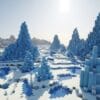The Flower Forest biome in Minecraft is one of the most breathtaking and resource-rich places in the Overworld. Known for its rolling green hills, vibrant flower patches, and the constant hum of bees, this biome is a favorite for builders, decorators, and resource gatherers alike.
Whether you’re looking to collect every dye color, start a bee farm, or just build a cottage surrounded by color, the Flower Forest offers unmatched beauty and utility.
Overview of the Flower Forest Biome
Introduced in Minecraft Java Edition 1.7, the Flower Forest is a temperate forest variant characterized by lush terrain and dense flower generation.
- Climate: Temperature 0.7 | Downfall 0.8
- Weather: Regular rain, no snow
- Terrain: Rolling hills with occasional ponds and oak or birch trees
- Grass Color: Bright, vibrant green
Flower Forests generate most often between plains, forests, and rivers, making them transitional yet visually distinct. Their elevated landscape and colorful vegetation make them easy to spot, even from afar.
All Flowers Found in the Flower Forest
The Flower Forest is the only biome that generates nearly every flower in Minecraft, making it essential for dye collection and decorative blocks.
Small Flowers
- Dandelion
- Poppy
- Blue Orchid (does not generate here — only in Swamps)
- Allium (exclusive to Flower Forest)
- Azure Bluet
- Red, Orange, White, and Pink Tulips
- Oxeye Daisy
- Cornflower
- Lily of the Valley
Tall Flowers
- Rose Bush
- Peony
- Lilac
Excluded Flowers
- Wither Rose (only appears when mobs are killed by the Wither)
- Sunflower (spawns only in the Sunflower Plains)
💡 Fun Tip: Because this biome includes every dye-producing flower except a few biome-specific ones, it’s the best location to create an automatic dye farm.
Flower Uses and Farming Tips
- Dyes: Each flower can be crafted into a unique dye color — perfect for banners, armor trims, candles, and beds.
- Suspicious Stew: Flowers like Oxeye Daisy and Lily of the Valley grant special effects when used in stews.
- Composting: Flowers contribute high compost value, useful for generating bone meal.
- Flower Farming:
- Using bone meal on grass blocks in a Flower Forest will only generate flowers that naturally occur in that specific biome.
- This makes it ideal for targeted flower farming — you can collect dozens of colors quickly with little effort.
Mobs and Wildlife
The Flower Forest is alive with peaceful creatures and buzzing bees.
Passive Mobs
- Bees: Spawn naturally on trees with bee nests.
- Oak and birch trees have a 5% chance to generate with a bee nest if grown within 2 blocks of any flower.
- In naturally generated Flower Forests, the chance of a bee nest on a tree is 10 times higher than in regular forests.
- Sheep, Rabbits, and Cows: Commonly spawn.
- Wolves: Do not spawn in this biome, unlike normal forests.
Hostile Mobs
At night, expect standard Overworld spawns such as:
- Zombies
- Skeletons
- Creepers
- Spiders
🌼 Pro Tip: Use flowers and campfires to safely harvest honey and honeycomb from bee nests — ideal for renewable farming setups.
Structures and Generation Features
While villages don’t generate inside the Flower Forest, the biome can host or border several natural structures:
- Bee Nests: Common on oak and birch trees.
- Ruined Portals: Occasionally spawn at biome edges.
- Small Caves and Ponds: Naturally scattered across the hilly terrain.
Its terrain variation and rich vegetation make it perfect for decorative builds or base integration with natural landscapes.
Hidden Secrets and Fun Facts
- Alliums are exclusive to this biome — nowhere else in the Overworld spawns them naturally.
- It contains the highest flower density of any biome.
- In Minecraft 1.15, bees and bee nests were added to the Flower Forest.
- Bees pollinating flowers can speed up crop growth for nearby farmland — making this biome ideal for efficient agriculture.
- The color of the grass and foliage is slightly more saturated than in normal forests, enhancing its visual appeal.
How to Find a Flower Forest
Because it’s rarer than standard forests, locating a Flower Forest requires exploration or use of commands.
Finding Tips
- Look for bright color clusters on hills near plains or rivers.
- They often border Birch Forests or Meadows in newer world generations.
- Use the command: /locate biome minecraft:flower_forest
- Tools like Chunk Base or Amidst can help locate one via your world seed.
Survival and Building Tips
- Bee Farming: Use existing nests to create a renewable honey and honeycomb source.
- Cottage Builds: The natural scenery makes this biome perfect for fantasy or cottagecore builds.
- Light Up the Area: The dense flower cover can obscure mobs — torches help prevent surprise attacks.
- Resource Hub: Between dyes, honey, and farmland potential, this biome is one of the best early-game bases.
💡 Tip: Combining the Flower Forest with nearby plains gives you space for large farms while keeping scenic views.
Flower Forest vs. Other Biomes
| Feature | Flower Forest | Forest | Birch Forest | Dark Forest | Meadow |
|---|---|---|---|---|---|
| Flower Variety | Nearly all flowers | Few | Minimal | Almost none | Moderate |
| Bee Nests | Very common | Rare | Uncommon | Rare | Common |
| Wolves | None | Common | Common | Rare | None |
| Terrain | Rolling hills, open patches | Dense trees | Light, tall trees | Shaded, thick | Flat, open |
| Aesthetic Appeal | Vibrant and colorful | Neutral | Bright | Dark | Pastel, alpine |
| Rarity | Uncommon | Common | Common | Uncommon | Uncommon |
🌻 The Meadow biome, added in Minecraft 1.18, shares many features with the Flower Forest — both are filled with flowers and bees. However, Meadows are treeless, flatter, and have a lighter grass tone, making Flower Forests feel denser and more whimsical.
Version History
| Version | Change |
|---|---|
| 1.7 (Java) | Flower Forest biome introduced |
| 1.15 | Bee nests and bees added |
| 1.18 | Terrain generation changes (hills, meadow adjacency) |
| 1.20+ | Minor worldgen tweaks, improved vegetation blending |
Conclusion
The Flower Forest biome is a vibrant masterpiece of color and life in Minecraft. With every flower type, thriving bees, and abundant resources for dyes and honey, it’s a biome that combines both beauty and practicality.
Whether you’re setting up a bee farm, building a storybook cottage, or simply exploring the landscape, the Flower Forest remains one of the most enchanting and rewarding places in the game.
If you see Alliums, Tulips, and buzzing bees, you’ve discovered Minecraft’s most beautiful paradise.






